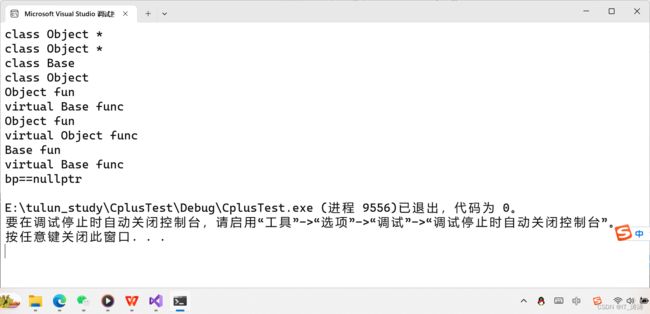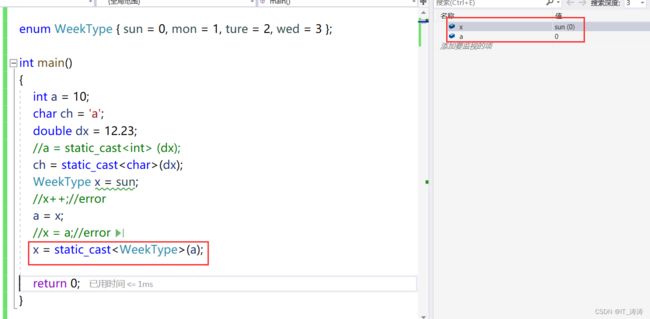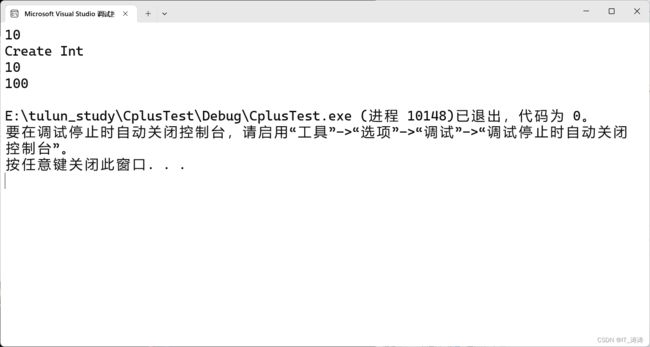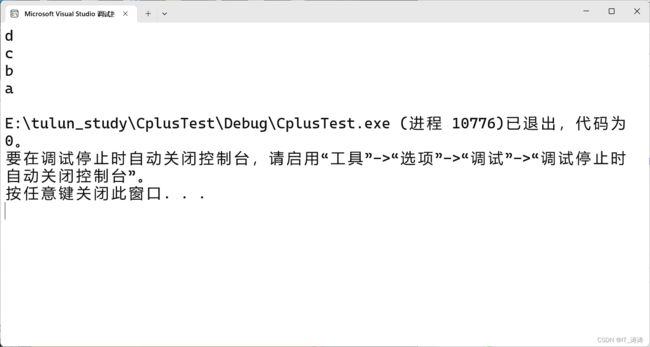C++四种基本类型转换
C++四种基本类型转换
- 1.static_cast
-
- 基本类型转换
- 指针转换的限制
- 左值转右值
- 上下行转换
- 2.const_cast
-
- 去常性
- const 编译时的替换
- 3.reinterpret_cast
-
- 指针类型间的强制转换
- 4 .dynamic_cast
-
- 初识动态转换
- 验证多态才能实现动态转换
- 反向 多态
1.static_cast
用法: static_cast
说明:该运算符把expression转换为typen_name类型,static_cast在编译时使用类型信息执行转换,在转换执行必要的检测(诸如指针越界计算,类型检查等);但没有运行时类型检查来保证转换的安全性。
枚举是收到限制的整型,取值范围收到限制,枚举不能++
静态转换两者类型要兼容,而且不能去常性,但是可以加常性
无类型指针可以转成任意类型
基本类型转换
enum WeekType { sun = 0, mon = 1, ture = 2, wed = 3 };
int main()
{
int a = 10;
char ch = 'a';
double dx = 12.23;
//a = static_cast (dx);
ch = static_cast<char>(dx);
WeekType x = sun;
//x++;//error
a = x;
//x = a;//error
x = static_cast<WeekType>(a);
return 0;
}
指针转换的限制
int main(){
int a = 10;
int* p = &a;
int* s = static_cast<int*>(&a);
int* s = nullptr;
const int* cp = static_cast<const int*>(&a);
//char* chp = static_cast(&a);//error
//s = static_cast(cp);//error;静态转换类型必须一致
s = const_cast<int*>(cp);
}
左值转右值
int main() {
int a = 10;
int &x= a;//左值
//int&& rx = a;//error
int&& rx = static_cast<int&&>(a);
return 0;
}
rx x 都是a的别名
上下行转换
class Object {
private:
int value; public:
Object(int x = 0) : value(x) {
cout << "Create Object: " << endl;
}
~Object() {
cout << "Destory 0bject" << endl;
}
};
class Base : public Object {
private: int num; public:
Base(int x = 0) : Object(x + 10), num(x) {
cout << "Create Base " << endl;
}
~Base() {
cout << "Destroy Base" << endl;
}
};
int main() {
Object* op = nullptr;
Base* bp = nullptr;
Base base;
Object obj;
op = &obj;
bp = &base;
op = bp;
//bp = op;//error
op = static_cast<Object*>(&base);
bp = static_cast<Base*>(&obj);
return 0;
}
bp = static_cast
上行转换安全,下行转换不安全
2.const_cast
用法:const_cast
可以适用基本类型,也可以用在自己设计的类型
说明:该运算符用来修改类型的const或volatile属性。除了const或volatile修饰之外,typename和expression的类型是一样的。
去常性
特点:
1)用于去除变量的只读属性
2)强制转换的目标类型必须是指针或引用
int main() {
int a = 10;
const int* ap = &a;
const int& ra = a;
//int* ip = ap;
//int& r = ra; 编译不通过
int* ip = const_cast<int*>(ap);
int& r = const_cast<int&>(ra);
}
const 编译时的替换
class Int {
private:
int value;
public:
Int(int x = 0) :value(x) {
cout << "Create Int" << endl;
}
~Int() { }
void SetValue(int x) {
value = x;
}
int GetValue() const { return value; }
};
int main() {
const int ca = 10;
int* cap = const_cast<int*>(&ca);
*cap = 20;
cout << ca << endl;
const Int a(10);
//Int* p = &a;//error
cout << a.GetValue() << endl;;
Int* p = const_cast<Int*>(&a);
p->SetValue(100);
cout << a.GetValue() << endl;
Int& aa = const_cast<Int&>(a);
aa.SetValue(200);
cout << a.GetValue() << endl;
}
由于ca是常整型,但是在编译的时候,ca已经被替换成了10,虽然它确实是变成了20,但是打印的还是10
而Int就不一样了,是常对象,去常性后,就可以修改
3.reinterpret_cast
用法: reinpreter_cast
说明: type_name必须是一个指针、引用、算术类型、函数指针或者成员指针。它可以把一个指针转换成一个整数,也可以把一个整数转换成一个指针。类似C语言的强转。
特点:
不适用基本数据类型之间的转换
用于指针类型间的强制转换
指针类型间的强制转换
int main() {
int a = 0x61626364;
//char* p = &a;//error
char* p = reinterpret_cast<char*>(&a);
cout << *p << endl;
p += 1;
cout << *p << endl;
p += 1;
cout << *p << endl;
p += 1;
cout << *p << endl;
return 0;
}
class Object {
private:
int value;
public:
Object(int x = 0) : value(x) { }
~Object() {}
int& Value() { return value; }
const int& Value() const { return value; }
};
int main() {
Object obj(10);
int* p = reinterpret_cast<int*>(&obj);
int& a = reinterpret_cast<int&>(obj);
cout << obj.Value() << endl;
*p = 100;
cout << obj.Value() << endl;
a = 200;
cout << obj.Value() << endl;
return 0;
}
对象和对象中的数据成员value是同一个地址
4 .dynamic_cast
语法: dynamic_cast
说明: dynamic_cast操作符,它允许在运行时刻进行类型转换,从而使程序能够在一个类层次结构中安全地转换类型,把基类指针转换成派生类指针,或把指向基类的左值转换成派生类的引用。
必须是公有继承,基类要有虚函数。
特点:
1.与C++支持的其他强制转换不同的是,dynamic_cast是在运行时执行的类型转换。
⒉.如果针对指针类型的dynamic_cast失败,则dynamic_cast的结果是nullptr。
3.如果针对引用类型的dynamic_cast失败,则dynamic_cast会抛出一个异常。
4.在类层次间进行上行转换时,dynamic_cast和static_cast的效果是一样的。
5.在进行下行转换时,dynamic_cast具有类型检查的功能,比static_cast更安全。
初识动态转换
class Object {
private:
int value;
public:
Object(int x=0):value(x){}
~Object(){}
virtual void func() { cout << "virtual Object func" << endl; }
void fun() { cout << "Object fun"<<endl; }
};
class Base :public Object {
private:
int num;
public:
Base(int x=0):Object(x),num(x+10){ }
~Base(){}
virtual void func(){ cout << "virtual Base func" << endl; }
void fun() { cout << "Base fun" << endl; }
};
int main() {
Object* op1 = nullptr, * op2 = nullptr;
Object obj(10);
Base* bp = nullptr;
Base base(10);
op1 = &base;
op2 = &obj;
op1->fun();
op1->func();
op2->fun();
op2->func();
bp = dynamic_cast<Base*>(op1);
bp->fun();
bp->func();
return 0;
}
总结:
Object* op1 = nullptr, op1 = &base; op1在用静态函数时,他就是Object*, 但是有虚函数时,就是Base*,通过动态转换Base* bp = nullptr;, bp = dynamic_cast

验证多态才能实现动态转换
int main() {
Object* op1 = nullptr, * op2 = nullptr;
Object obj(10);
Base* bp = nullptr;
Base base(10);
op1 = &base;
op2 = &obj;
//指针类型信息
cout << typeid(op1).name() << endl;
cout << typeid(op2).name() << endl;
cout << typeid(*op1).name() << endl;
cout << typeid(*op2).name() << endl;
op1->fun();
op1->func();
op2->fun();
op2->func();
//op1指向&base,可以动态转换
bp = dynamic_cast<Base*>(op1);
bp->fun();
bp->func();
//op1指向&obj,不可以动态转换
bp = dynamic_cast<Base*>(op2);
if (bp == nullptr) {
cout << "bp==nullptr" << endl;
}
else bp->func();
return 0;
}
typeid(*op1).name() 能知道指针所指之物是存储了类型识别信息

反向 多态
int main() {
Object obj(10);
Base* bp = nullptr;
Base base(10);
Object* op1 = &base;
Object* op2 = &obj;
//Base* bp1 = &obj;//err
Base* bp1 = static_cast<Base*>(&obj);//作用就是编译通过 逻辑上不行
Base* bp2 = &base;
bp1->fun();
bp1->func();
bp2->fun();
bp2->func();
return 0;
}





